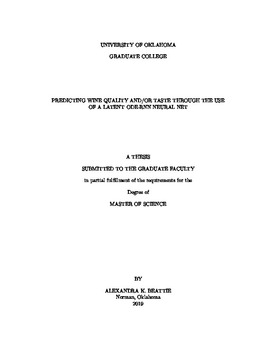| dc.contributor.advisor | Hougen, Dean | |
| dc.contributor.author | Beattie, Alexandra | |
| dc.date.accessioned | 2020-01-27T21:01:20Z | |
| dc.date.available | 2020-01-27T21:01:20Z | |
| dc.date.issued | 2019-12-13 | |
| dc.identifier.uri | https://hdl.handle.net/11244/323321 | |
| dc.description.abstract | It is common for recommendation systems to use clustering techniques for finding similar products for the downstream user. These models do not always incorporate time as a variable when recommending an item. If our recommendation models do not include time, it may be difficult to surface the correct product to downstream users, given that seasonality tends to affect user behaviors.
Time is not frequently used in recommendation algorithms due to the difficulty of obtaining continuous or consistent time series data of user interactions. Recently, Ordinary Differential Equation Recurrent Neural Networks (ODE-RNNs) has been flagged as a possible solution for predicting inconsistent time series data. This algorithm can bypass the need for consistent time data via its Recurrent Neural Network (RNN) encoder, which transforms the data with inconsistent time steps into hidden latent states that capture its temporal element. These encoded states are inputted into the Ordinary Differential Equation (ODE) block of the computational graph to solve the initial value problem of the hidden latent states. This solution results in a function that describes how the states change in continuous time. This new development is a possible solution for creating specific recommendations accounting for how tastes change over time.
To determine the feasibility of the above method for recommendations, a high-dimensional time series dataset is reduced into a two-dimensional dataset with time as a feature. This dataset is used to train an ODE-RNN model to predict how it changes over time. Reviews from the Wine Enthusiast are used to create the original high-dimensional time series dataset. The wine reviewers will represent the users to predict, and the high scoring wines will be used to predict the taste trends of the reviewer. | en_US |
| dc.language | en_US | en_US |
| dc.rights | Attribution-NonCommercial-NoDerivatives 4.0 International | * |
| dc.rights.uri | https://creativecommons.org/licenses/by-nc-nd/4.0/ | * |
| dc.subject | Neural Network Predictions | en_US |
| dc.subject | Ordinary Differential Equations | en_US |
| dc.subject | Machine Learning | en_US |
| dc.title | Predicting wine quality and/or taste through the use of a latent ODE-RNN Neural Net | en_US |
| dc.contributor.committeeMember | Nicholson, Charles | |
| dc.contributor.committeeMember | Radhakrishnan, Sridhar | |
| dc.date.manuscript | 2019-12-07 | |
| dc.thesis.degree | Master of Science | en_US |
| ou.group | Gallogly College of Engineering | en_US |
| shareok.orcid | 0000-0003-3351-5951 | en_US |

